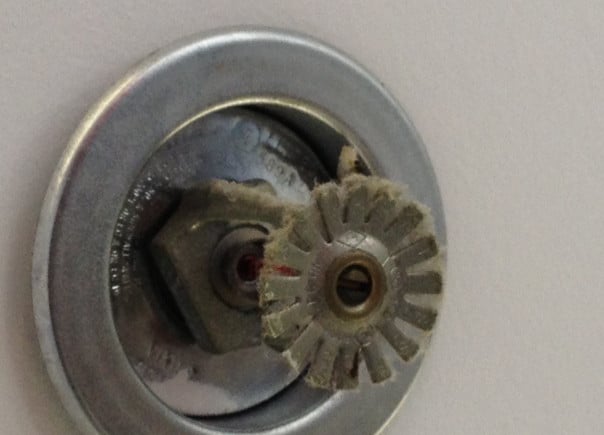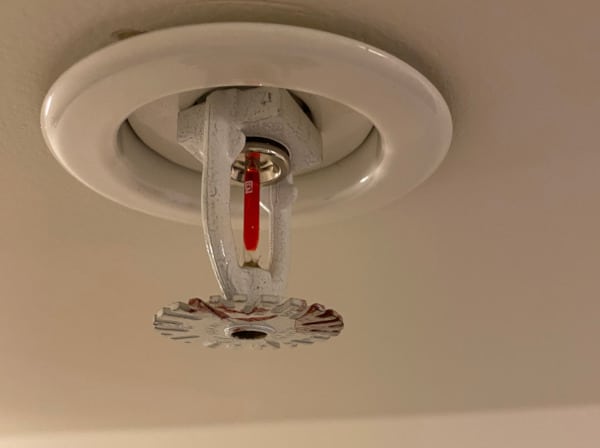Dirty fire sprinklers can impair performance and violate code
A dirty fire sprinkler doesn’t just look bad—it’s a potential code violation. Dirty, dusty, painted, or corroded fire sprinklers are all common compliance issues.
That’s because grease, caulk, paint, dust, and corrosion can all prevent fire sprinklers from working as designed. Every fire sprinkler has a heat-sensitive element: either a fusible metal link or a liquid-filled bulb. This element should respond quickly in the event of a fire—but it might not if substances cover and insulate it against heat. That’s why inspectors will write you up for seemingly cosmetic problems.
If your sprinkler has problems like this, you have to replace it unless you can safely clean it. While substances like paint always call for replacement, fortunately, you can do something about dirt and dust.
In this article, we’ve got answers to your questions about cleaning and maintaining fire sprinklers.
Vacuuming or using compressed air are the only NFPA-compliant, no-touch ways to clean dirty fire sprinkler heads. Read our latest guide to the options and you can purchase air dusters from QRFS.
What are the rules for maintaining fire sprinkler heads?
The standard for fire sprinkler upkeep—NFPA 25: Standard for the Inspection, Testing, and Maintenance of Water-Based Fire Protection Systems (2020 edition)—has clear language prohibiting “loaded” fire sprinklers.
NFPA 25 (5.2.1.1.1) says that you have to replace a fire sprinkler head if it:
- Leaks
- Has significant corrosion on any functional part (like the deflector)
- Is physically damaged
- Has lost fluid in the glass bulb
- Is loaded (e.g., dirty) in a way that would inhibit performance
- Gets post-manufacturer paint on it
Keep your sprinkler heads as close to new as possible—no damage, no significant corrosion, no massive dirt or dust, and definitely no new paint. Otherwise, you’ll have to replace it. And it pays to avoid replacing sprinkler heads.
Read more about fire sprinkler replacement and corrosion-resistant fire sprinklers in our previous blogs.
Fortunately, however, there is an exception to replacement for some dirty sprinklers.
How do you clean fire sprinklers?
Fortunately, you can clean dirty or dusty fire sprinklers instead of replacing them, as long as you do it correctly.
The NFPA 25 5.2.1.1.1 annex says that “it is permitted to clean sprinklers with compressed air or by a vacuum provided that the equipment does not touch the sprinkler.”
The right mechanisms don’t require contact with the sprinkler head. This is critical because heat-sensitive elements can be very fragile. If you accidentally break a sprinkler head while cleaning it, you’ll have to deal with a lot of water instead of a little dust.
Compressed air is an option, though it often involves using ladders and could possibly harm a sprinkler if you get too close and contact the sprinkler. The SprinklerVac vacuum hose attachment has been the easiest way to clean fire sprinklers. This vacuum nozzle has a 4-1/2” mouth, fitting over sprinkler heads to suck up dust, dirt, and cobwebs. It features a connection for standard 1-1/4″ and 1-1/2″ vacuum hoses.
Update: The SprinklerVac has been discontinued. Read this guide to the current methods of cleaning fire sprinklers, including using compressed air.
To clean fire sprinkler heads with this tool, simply:
- Attach the SprinklerVac to your vacuum hose, ensuring it is securely fastened.
- Assess the accessibility of your sprinkler heads to ensure the SprinklerVac will clean them “touchlessly.”
- Turn the vacuum on.
- Carefully place the SprinklerVac over the fire sprinkler.
- Look through the clear plastic to monitor your placement and cleaning progress.
- Watch the dust, dirt, and cobwebs whirl away!
- Rinse the SprinklerVac with warm water and dry it with a soft cloth.
How often should you clean your fire sprinklers?
If you’re trying to avoid being dinged by an inspector for dirty sprinklers—and you want to make sure they work—it pays to keep up proper maintenance. But NFPA 25 does not set or suggest a specific cleaning schedule. The rule is simply this: if they’re dirty, clean them.
NFPA 25 says (5.2.1.1.1) that loading becomes a problem when it is “detrimental to sprinkler performance.” Interpreting this phrase is up to the discretion of the inspector and the authority having jurisdiction (AHJ).
Simply remember that dust is a problem when it insulates the sprinkler element. A few flecks of it here and there or a cobweb strand may not be viewed as a problem (unless you need to maintain a sanitary environment). But a substantial coating that could impair performance will be written up.
To come up with a cleaning schedule, you have a few options. First, you (or your contractor) should certainly check for sprinkler loading during the annual from-the-floor visual inspection required by NFPA 25. If you find dirty heads, clean them! Alternatively, gauge how quickly dust and dirt tend to build up on sprinklers and other surfaces in your facility, and set an institutional cleaning schedule based on that assessment.

Can you clean paint off fire sprinkler heads?
Paint isn’t like dust, dirt, or cobwebs, of course. If you accidentally get paint on a fire sprinkler head, you have to replace it—no questions asked. Solvents, abrasives, or scrubbing are not allowed. NFPA 25 has zero tolerance for any paint on a head that isn’t put there by the manufacturer. The sprinkler must be replaced.
It’s far better to avoid it in the first place. Simply use convenient Fire Sprinkler Paint Covers. They slip on—no need to touch the sprinkler head—and feature an adhesive backing that’s easy to stick and remove. Paint covers make it easy to use spray paint, rollers, or brushes without worrying about hitting the sprinklers.
Keep your fire sprinkler heads clean to avoid code compliance issues
A fire sprinkler inspector can write you up for having dirty sprinklers—and many do, as it’s one of the most common compliance issues. The reason for this is simple: fire sprinklers operate based on heat, and a buildup of anything that could insulate them against those high temperatures can stop or delay activation.
If a sprinkler is painted or significantly corroded, it has to be replaced. But dirty and dusty sprinklers can be cleaned—if you don’t touch them.
Check out our latest guide to the options for cleaning sprinklers and you can purchase air dusters from QRFS.



